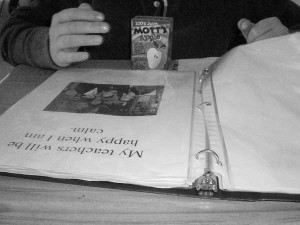
A great resource to use to help children with autism are Social Stories. Developed by Carol Gray, a Social Story describes a situation, skill, or concept in terms of relevant social cues, perspectives, and common responses in a specifically defined style and format. It explains what is happening and why it is occurring. It is primarily used for social behaviors and routines you want to increase and those situation that are new and anxiety-provoking. Stories are always personal, positive and short. Within an ABA program, Social Stories are used to help with transitions, school routines, dentist trips, hair cut trips and any other social behavior you want increased.
Components Of The Social Story
All Social Stories should have certain components in order to make it a Social Story. There are four types of sentences found in a Social Story.
- Descriptive Sentences – Sentences that describe where the situation occurs, the individuals involved and what they are doing and why. They also describe the social setting and the steps involved for completing the activity within the situation.
- Perspective Sentences – These describe how other people feel and how they react to the situation. These are used primarily to reflect others’ perspectives.
- Directive Sentences – These describe the responses the child should make and the actions to complete the activity. The behavior the child should exhibit is always described in positive terms. Since the stories are personal, sentences usually begin with, “I will try to,” or “I will work on.”
- Control Sentences – The child usually writes these sentences and they are strategies to remind them about the social story’s information. This step doesn’t have to be used for lower-functioning or smaller children.
Social Stories Characteristics
Social Stories should always be written in the first person and describe a present or future social situation that the child is having difficulty with. A key characteristic of Social Stories is pictures or illustrations as many children with autism are visual learners. Vocabulary is appropriate to the development of the child.
When writing the story, maintain two to five descriptive sentences for every directive sentence, no matter the length of the story. Read the story to the child several times and it is always a good idea to model the behavior afterward.
Do The Following When Writing Social Stories
- Describe the setting in simple terms
- Use 1-3 sentences per page with visual representations to simplify the story
- Name the people in the story
- State the events in order
- Provide reasons why things occur
- Provide responses for the child that is appropriate for the situation
An Example Of A Social Story
Asking To Play
At school, there are many toys to play with like: cars, trains, blocks, puzzles and bead mazes.
When it is play time, all the children pick toys to share and take turns. If I want to play with a toy I must remember to:
– First go to the person and ask, “Can I play with you?” or “Do you want to play together?” or “Can I join you?”
- Next I need to wait and listen. They might say, “Okay” or “Sure” and they might say “No.” This is no big deal.
It’s important to always ask to play with a toy. When I remember to ask, my teachers and friends are happy with me.
Related posts:
- Social Reinforcement for Verbal Children When I first started doing ABA therapy, I found it...
- A General Overview of Autism and ABA Therapy The use of ABA therapy to teach child autism has...
- Understanding Autism and Autism Treatments It was my father who gave me my first gut-level...
Comments are closed.